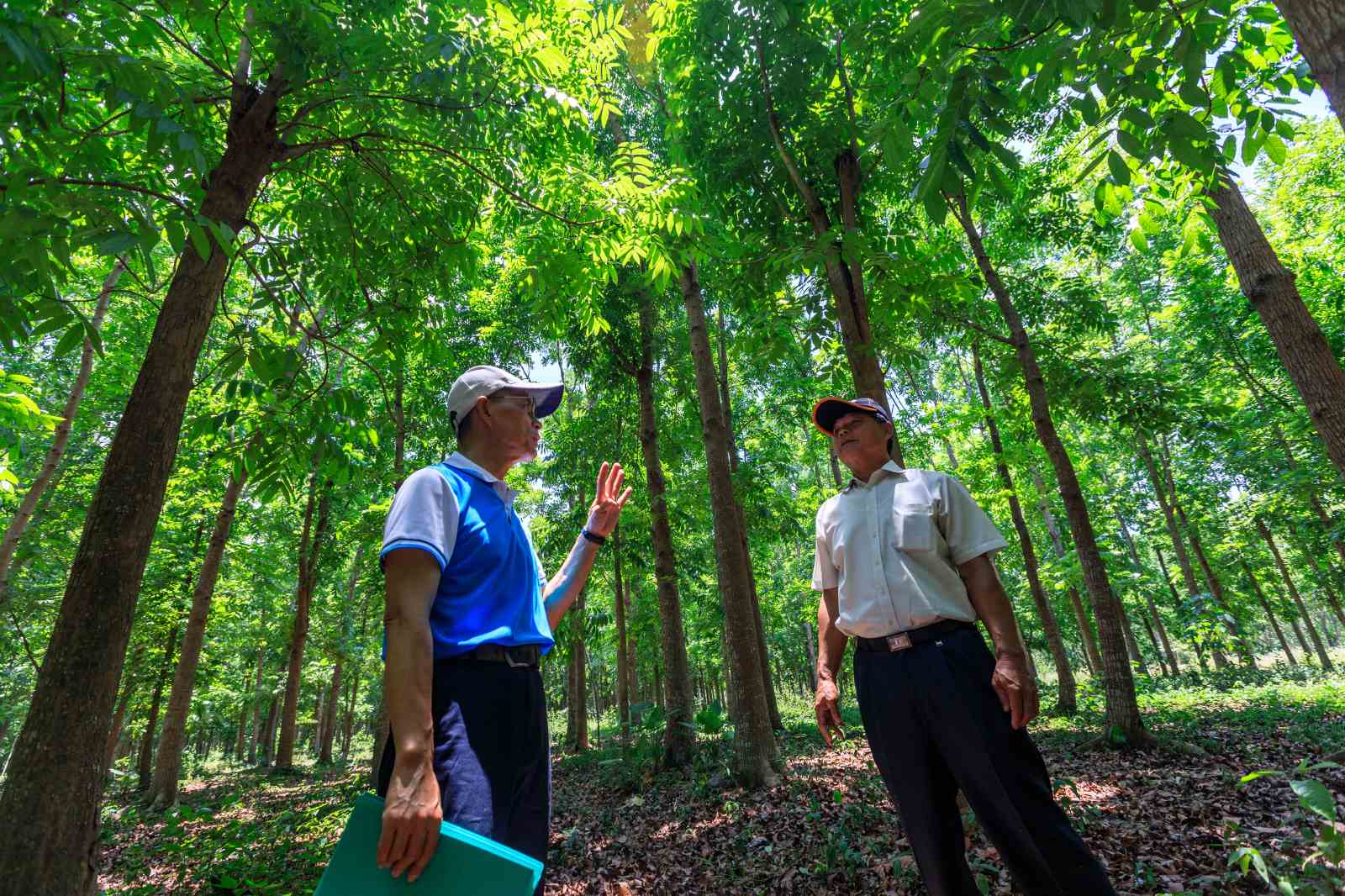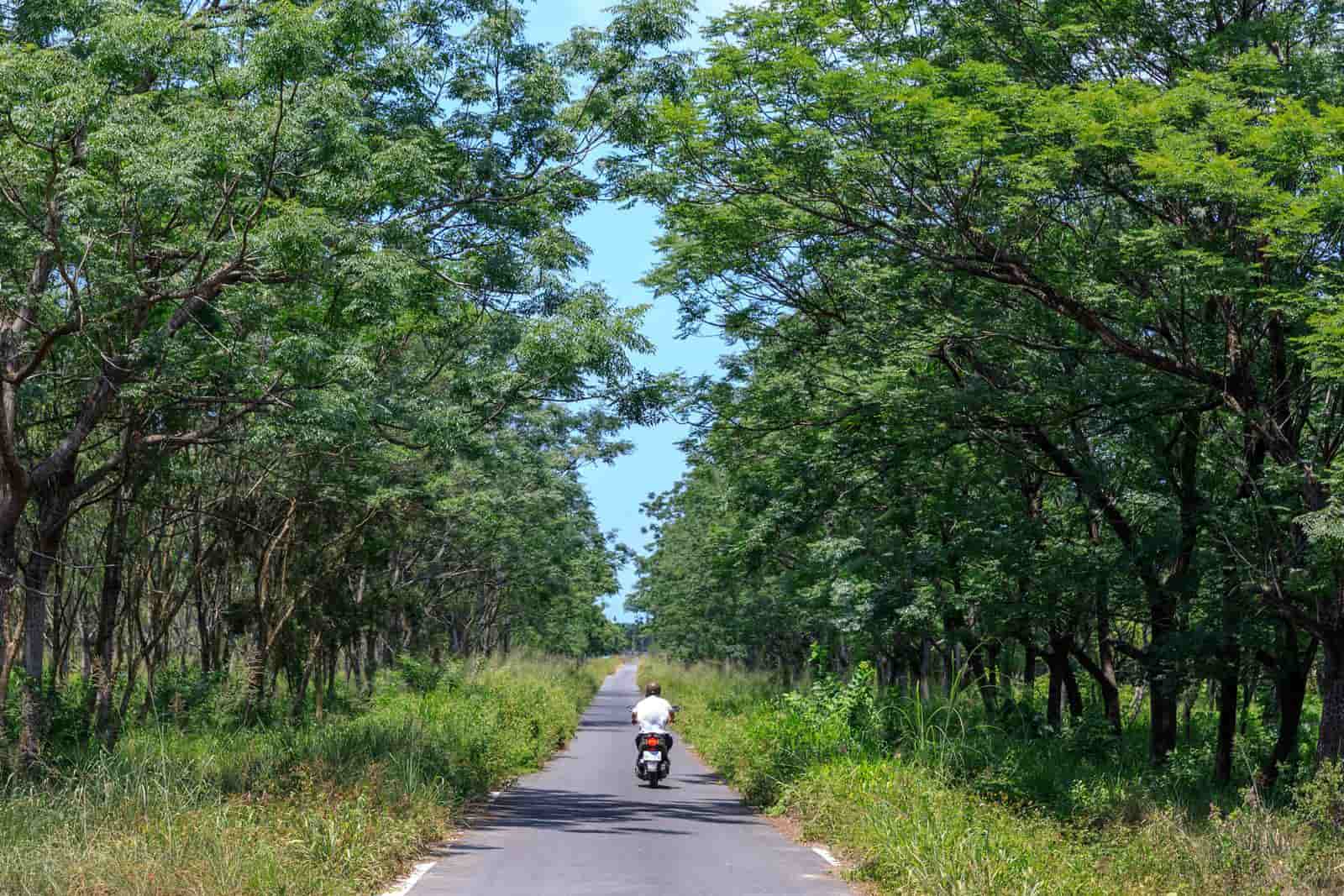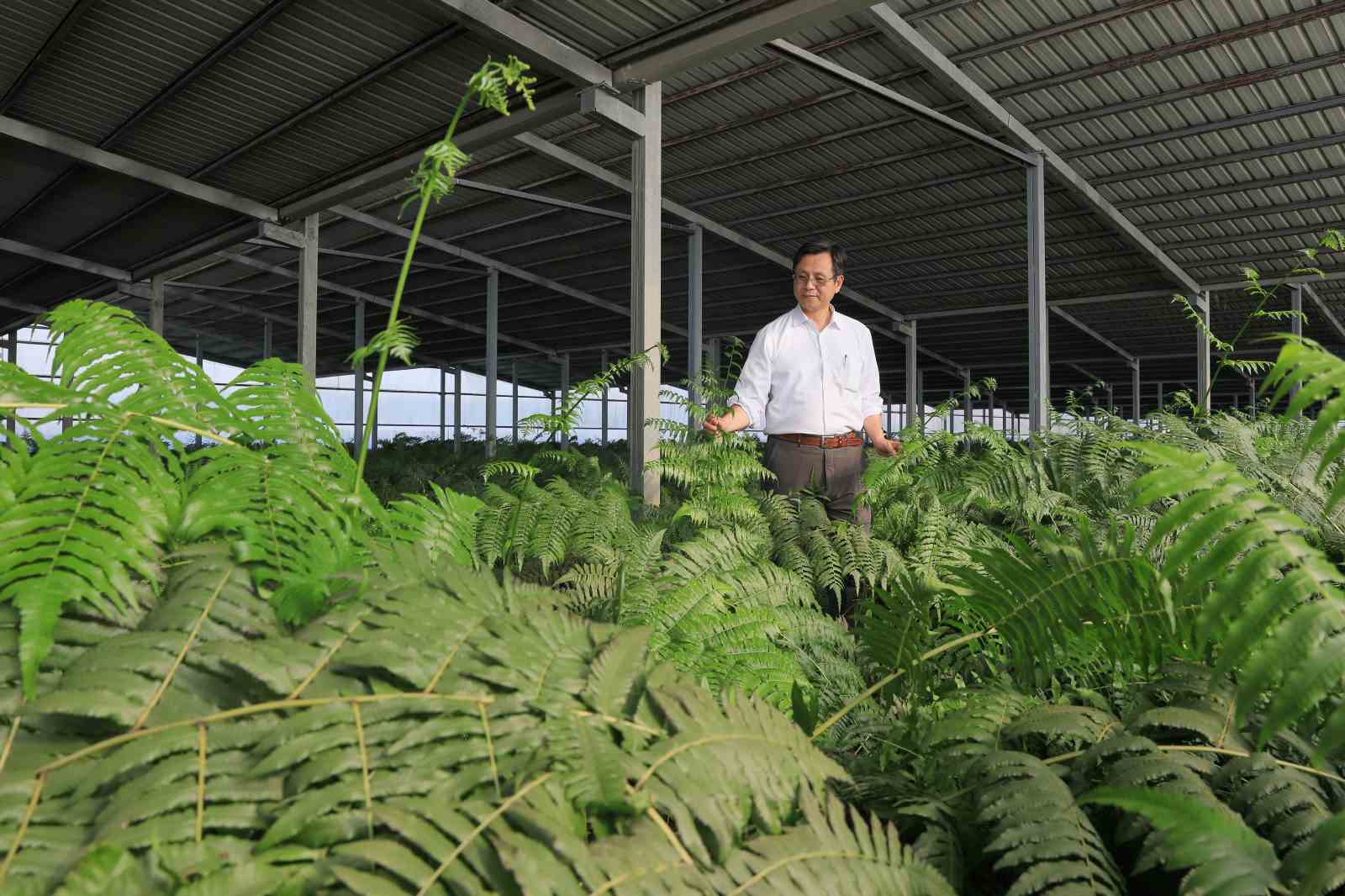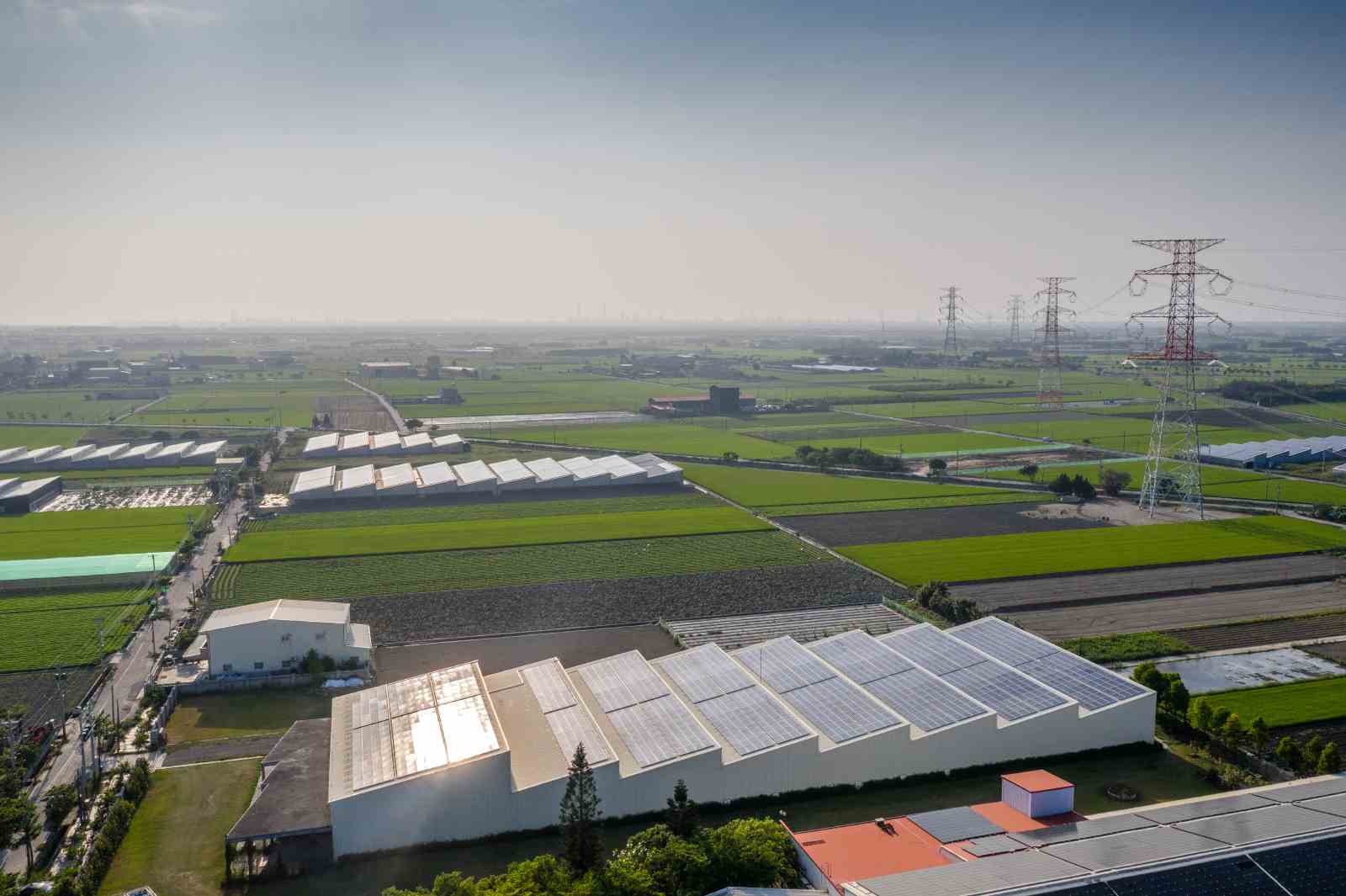Will a 20-Year-Old Forest be Chopped Down to Produce Solar Power?

Source:Chien-Ying Chiu
County Highway 185 in Pingtung is nestled in a sea of greenery that has enticed countless tourists. Taiwan Sugar Corporation spent twenty years nurturing this swath of woodland. Now, they are said to be cutting part of it down to make room for solar power plants. From planting trees to felling them, what does it mean for the surrounding countryside?
Views
Will a 20-Year-Old Forest be Chopped Down to Produce Solar Power?
By Kuo-Chen Lu, Laura Kang, Yi-Chih Wang and Liang-rong ChenFrom CommonWealth Magazine (vol. 700 )
Down in southern Taiwan, there is a country road that winds its way through grass and trees, with honeybees and butterflies to keep it company. This is County Highway 185. Beekeepers bring their bees here to make honey. On holidays, children play along the road. The forest stretches for as far as the eye can see. However, the trees are neat and organized, resembling an orderly army of green.
This is Taiwan’s largest man-made forest. Eighteen years ago, Taiwan Sugar planted trees over an area of 10,815 hectares—that’s more than 400 times larger than Daan Forest Park in Taipei. Now, this forest is slated for the chopping block. In its place will likely be a massive collection of solar panels that can generate more electricity than the unfinished Lungmen Nuclear Power Plant. This is being done to comply with Apple’s demand that its global supply chain—including its contractors in Taiwan—make ample use of renewable energy.
The trade-off is clear: no more sunny days, clean air, or pure water for the nearby residents. A carbon sink that scrubs 200,000 metric tons of carbon dioxide from the air annually, significantly alleviating the effects of global warming, will also be gone. Everything turns to nothing. Why do people plant trees only to chop them down?
Taiwan’s First Large-scale Man-made Forest
Scrubs 200,000 Metric Tons of Carbon Dioxide Annually
Things were different twenty years ago. “This place was often an inferno,” recalls Guo-shun Lin (林國順), native son and Head of Wanluan Township in Pingtung. After the sugarcane harvest, leftover sugarcane leaves were often set ablaze on the spot. The ashen wasteland that remained would be the new landscape for a while, until the next batch of sugarcane had matured and the cycle began anew.
The Kyoto Protocol, signed in 1997, brought change to this region. Chen Chao-yi (陳昭義), Chairman of Taiwan Sugar Corporation and former Director General of the Industrial Development Bureau, recounts the historical background that put the policy in place. The initial reason was the signing of the Kyoto Protocol, which committed major industrial countries around the world to decreasing greenhouse gas emissions and reducing their carbon footprints.
As a major trading nation, Taiwan consumed a great deal of energy and pumped a vast amount of carbon into the atmosphere. The administration sensed the potential impact of the Kyoto Protocol, and enacted a tree-planting policy. “The government’s goal was 60,000 hectares of trees, but there was little enthusiasm in the private sector. So, they turned to the state-run Taiwan Sugar Corporation,” says Chen.

In 2002, there was renewed interest in man-made forests. Taiwan has joined the World Trade Organization and opened its market to the world. The liberalization of the sugar industry hit Taiwan Sugar hard. Imported sucrose was far cheaper than anything Taiwan produced domestically. Taiwan Sugar had to shut down its sugarcane operations and find another use for its farmlands.
In a bid to lessen the impact of Taiwan joining the WTO, the Council of Agriculture introduced subsidies for fallow farmlands. Taiwan Sugar took the subsidy and converted the sugarcane plantations into a man-made forest.
In short, Taiwan Sugar planted the trees to support the administration’s effort to combat climate change and alleviate the effects of global warming. Countries across the globe were thinking up ways to cap and trade carbon emissions. Planting a forest produced a carbon sink, the value of which could be openly traded on the free market. The man-made forest was originally envisioned as a sustainable business.
Riding on the global wave to curb carbon emissions, Taiwan Sugar became a pioneer in the science of mass afforestation. The woods they created were estimated to scrub 200,000 metric tons of carbon dioxide from the air every year. Starting in 2002, the fields of sugarcane were replaced by a beautiful lattice of greenery. The trees are neatly lined up on both the eastern and western plains of southern Taiwan, like an army in green. Each hectare is home to as many as 2,000 trees.
Over the course of twenty years, Taiwan Sugar collected a total of NT$5.2 billion in subsidies. If we add private afforestation projects into the equation, the total value is around ten billion. The man-made forest has had a significant impact on the development of Pingtung, Hualien, and Tainan.
An Unexpected Windfall: Green Tourism
Man-made Forest, All-Natural Ecosystem
The former sugarcane fields changed into a blanket of green. Railroad tracks gave way to bicycle paths. Visitors were invited to spend a leisurely day cycling, enjoying the greenery, and breathing in the fresh air.
The trees matured. Flowers sprouted on woodland trails. Butterflies and bees moved in. Chien-kun Wang (王乾坤), owner of Chienkun Organic Farm, is a retired manager who used to work in chemical giants like Formosa Plastics Group and Nantex. By chance, he purchased a piece of farmland along County Highway 185, thus fulfilling his lifelong dream of retiring to the country.
Wang has worked with chemicals all his life. His organic farm is quite different from what you would expect. As a witness to the shift from sugarcanes to trees, Wang remembers, “The sugarcane farms required a lot of insecticide. It was the only way to control a massive plantation with minimum manpower.”
The Chienkun Organic Farm’s backyard is home to wild rabbits and squirrels. The five-colored Taiwan barbet visits in the morning; at night, there are owls. The man-made forest created a natural ecosystem that has attracted all kinds of leisure businesses. The clean water of Dawu Mountain, the fresh air of the woodlands, and the insecticide-free environment allow for the culture of quails, the harvesting of cocoa, and the establishment of villas and leisure farms. Pingtung County put every effort into developing its own tourism industry. The Association of Mountainside Tourism, Leisure, and Agriculture (沿山觀光休閒農業協會) was founded as the result.

The dream of reducing carbon emissions and improving the environment became reality—at least, in the eyes of the locals.
In the bygone days, who would have visited the sugarcane fields for a leisurely stroll? Now, retirees walk the woodlands and enjoy the fresh air from early morning until the evening. On weekends and holidays, cyclists come to bicycle in the shaded glades.
The case for Cutting Down Trees in the Name of Green Energy
Poor Combination of Seed and Soil Led to Substandard Tree Quality
Then, something happened that nobody expected. Last October, rumors surfaced that TSMC was investing 60 billion dollars to build Taiwan’s biggest solar power plant in Pingtung. The reason was that TSMC’s latest 3-nanometer semiconductor fabrication plant uses a great deal of energy; but tech giants like Apple are demanding that their global supply chain use green energy. The proposed location is near Taiwan Sugar’s Linhousilin Forest Park (林後四林平地森林園區). This brought the debate about cutting down trees to make way for green energy to the forefront.
Eighteen years, a carbon sink with an annual capacity of 200,000 metric tons, and ten billion dollars in subsidies—will all of this have been for the birds?
Chen provides testimony on the proposal to fell trees and build power plants. He himself has visited Wanluan many times. “Some trees are tall and strong, but others are sparse and low. There is disparity in the quality of the trees, because not all the soil there is suitable for forests. The result of the afforestation project has been poor, indeed,” he says, pointing to photographs of the woodland.
CommonWealth Magazine followed Taiwan Sugar staff into the man-made forest. Mahogany trees are faring very well. Evergreen ashes are doing so-so. Soapberry trees are neither flowering nor bearing fruits. The Golden shower, Chinese tallow, and Zelkova are doing the worst of all.
Why are some trees failing? Mass afforestation was an unprecedented attempt, and after all, Taiwan Sugar is no forestry expert. Oftentimes, Taiwan Sugar would just plant whatever saplings the Forestry Bureau at the Council of Agriculture had to offer. They did not consider what types of trees were suited to what kind of soil. They even tried planting trees that were native to middle or high elevations in tropical Pingtung. Needless to say, many of the trees had trouble adjusting.
In summary, the problem was a failure to take the big picture into account.
Compounding that was a rush to get the project started. Today, it is considered a failed policy. Chen quotes a line from Minister Chen Chi-chung (陳吉仲) of the Council of Agriculture, when he took questions from Legislator Kao Chin Su-mei (高金素梅) during a session at the Legislative Yuan: “Our current policy is problematic. Because prices are high, we work very hard to produce fruits and vegetables on mountain land. At the same time, we plant trees on the flatlands. This is an incorrect way to conserve soil and water. Flatlands are optimal farmlands, yet we engage in afforestation there. Meanwhile, we are importing large quantities of soy, corn, and wheat. We’re going about it all wrong.”

Of course, the whole project is not a wash. It has preserved precious farmland, and it has helped to reduce carbon. But from an economic point of view, parts of the forest are just not sustainable. Taiwan Sugar is also doing its own calculations. The twenty meters of woodland on either side of the highway will not be touched, nor will trees that are well-developed, close to villages, or have sufficient ecological or economic value.
But the remainder of the trees will probably be chopped. In the first phase, Taiwan Sugar is ready to auction off 230 hectares of land to create an agrivoltaics park that supports both agriculture and solar energy.
Chen Chao-yi shifts his tone. Everyone wants a piece of green, a paradise where you can walk with your children. “But suppose it were your home; if you had no income, but needed to tend to a piece of land for others to come and enjoy; would you do it?”
In other words, Taiwan Sugar is reconsidering the future of its many large tracts of man-made forests. Other afforestation projects all over the country may be up for review as well.
Without Trees, Will Bees and Tourists Come?
Detractors: “Faux Farmland, Real Power Plant”
Lin was among the first to oppose the felling of trees to pave the way for power plants. He says, “For eighteen years, we’ve worked hard to plant these trees and nurture the environment. Cutting them down is regressive. Is green energy really more environmentally friendly? What good is it to pave the soil with cement? All we will have is electricity, and nothing else. Renewable energy is good for corporations, but it does nothing for the local people.”
The locals benefited from the natural beauty surrounding them. Cutting down the trees will deprive them of that livelihood. Chou Ke-jen (周克任), president of the Blue Donggang River Conservation Association (藍色東港溪協會), says there was another purpose to the afforestation project. It has restored the groundwater of Taiwan Sugar’s plots of fallow farmland. What’s more, it has prevented Taiwan Sugar from auctioning off the land.
“We need to reconsider. We seem to think that Taiwan has unlimited natural resources. We are investing in more and more power and water so semiconductor companies can sell chips overseas and enrich foreign investors. At the same time, they are levelling Pingtung’s trees and terminating the livelihoods of part of the population,” says Chou.
There are other places to build solar power plants. Tsai Shun-jou (蔡順柔), Director of the Pingtung County Good Women’s Rights and Interests Development Association (屏東好好婦女權益發展協會), points out: “We are not against solar energy. But we should debate where it is suitable to build the solar power plants. A solar panel has a lifespan of only twenty years. Trees can go on for hundreds, even thousands of years. Twenty years from now, we will have no trees, and the land will be unusable for farmers. The green woodlands of County Highway 185 will have become the solar cell junkyard of County Highway 185.”
Chen stresses, “Agricultural land will be preserved for agricultural use.” Firstly, because the man-made forest will be converted into an agri-voltaics park, that means only 40% of the land may be covered by solar panels. The remaining 60% must be free for sunlight to shine through. Both solar cells and plant cells will have their share of the sun. Secondly, to counter charges of being “a faux farmland that’s actually a real power plant”, the yield of agricultural produce must not dip below 70% of the national average. Thirdly, there will be no cement pavement.
However, there are already too many cases of “faux farmland, real power plants” in Taiwan. Lin shows us a private solar farm in Wanluan. Beneath the solar cells, all that’s being grown are mushrooms. It is a sham, nothing more.
The Agri-Voltaics Dream of Mailiao in Yunlin
Mushrooms, Dumplings, and Crickets: An Integrated Approach
Can green power coexist with agriculture? In searching for an answer, we shifted our focus from Wanluan in Pingtung to Mailiao Township in Yunlin County. Hsin-fu Chiu (邱信富), Chairman of SolarFarm Corporation (晁陽農產科技), is one of the most recognizable faces in Taiwan’s photovoltaics industry in recent years. He has worked in Taipei’s financial sector for more than twenty years, amassing wealth and managerial experience.
In 2012, he and investors put a billion dollars into the development of 22 solar-powered greenhouses on 12 hectares of land in Lunbei, Baozhong, and Mailiao Townships in Yunlin. The amount of electricity they generate every year is enough to provide for 1,400 small families for a whole year.
“I don’t believe in using agriculture as a cover for generating power. If you are going to do it, then do it right. It is a dangerous precedent to pretend to be a farmer while neglecting a farmer’s duties.” Chiu worries that such misconduct will ultimately cost power plants their operating licenses.
For a time, it was good business to build power plants on farmlands in Taiwan. Simply generating power will make your money back in eight to ten years. Quite a few photovoltaics companies bought land, made a show of planting ferns and mushrooms, and then claimed they were preserving farmlands for agricultural use. The government has had to crack down on such illicit practices multiple times.
After Chiu bought out his investors and plunged into the dream of making solar power coexist with farm work, he began to realize that a difficult road lay ahead of him.
Early on, he consulted with experts at the Taiwan Agricultural Research Institute at the Council of Agriculture. The first thing they told him was a rude awakening. “They said, you can’t all grow mushrooms; you will crash the market,” Chiu recalls.
They were not wrong. The solar farms produced an abundance of mushrooms and fiddleheads, but no one was buying. Prices dropped to twenty to thirty dollars a kilogram. But the cost of harvesting was fifty dollars per kilogram. It made no sense to harvest or sell. Chiu truly experienced the difficulty of being a farmer.

Though he could not sell his coral mushrooms and fiddleheads, Chiu did not give up. He went downstream and sold dumplings, buns, and scallion pancakes. He learned about processed farm products, ecommerce, and branding. He even sold dumplings online. He taught students about agriculture and raised crickets with them. He successfully applied with the Council of Agriculture to open a recreational farm that promotes food and agriculture education.
It took him eight years, but the integrated approach eventually bore fruit. Speaking from experience, Chiu says it will be hard for businesses to survive just by selling produce, unless you already have a big market. It is impractical to plant things and expect them to fly off the shelves.
My Way or the Highway is a False Dichotomy
Done in Haste, Neither Afforestation nor Deforestation Will Help the Locals
Selling electricity is easy; selling produce is hard. Chiu laments that, “After eight years of exploration, agricultural products still bring in very little revenue, about one or two million per month. That’s peanuts compared to selling electricity, which brings in over sixty million a year.”
The prospects of power generation plus agriculture are not as rosy as some may think. Oftentimes farm work is only a front. The farmers in the fields of Wanluan know this much better than Taiwan Sugar or the government.

But there is a middle ground. If the 10,815 hectares of land does not generate revenue, everyone at Taiwan Sugar will naturally be thinking about how to fix that problem. “If the Council of Agriculture continues to subsidize us, perhaps we will not take any action at this time,” says Chen. There may be a win-win-win situation for forest, folks, and photovoltaics. The key is whether the land can benefit from subsidies, or perhaps create a new source of revenue.
The world may need renewable energy. But to chop or not to chop, that is a false dichotomy.
Taiwan does not lack places to build solar power plants. Felling trees to generate electricity is just an excuse to lower costs and benefit from inexpensive farmland.
Done in haste, neither afforestation nor deforestation will do locals any good. Chopping down trees and erecting solar panels is no guarantee for the future of the agricultural industry. And the cost will not only be the locals’ livelihoods and quality of life, but also the chance for us to peacefully coexist with our environment.
Have you read?
♦ Taiwan’s Renewable Market Revolution Taking Shape
♦ Strong Support Among Taiwanese for More Proactive Measures to Combat Climate Change
♦ In 2020, Taiwan’s Green Energy Will Power Tech Giants Like Apple and Google
Translated by Jack Chou
Edited by TC Lin
Uploaded by Judy Lu






